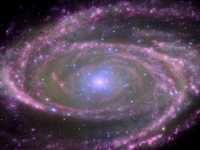The conservation of energy is an absolute law, and yet it seems to fly in the face of things we observe every day. Sparks create a fire, which generates heat—manifest energy that wasn’t there before. A battery produces power. A nuclear bomb creates an explosion. Each of these situations, however, is simply a case of energy changing form. Even the seemingly paradoxical dark energy causing the universe’s expansion to accelerate, we will see, obeys this rule.
The law of conservation of energy, also known as the first law of thermodynamics, states that the energy of a closed system must remain constant—it can neither increase nor decrease without interference from outside. The universe itself is a closed system, so the total amount of energy in existence has always been the same. The forms that energy takes, however, are constantly changing.
Potential and kinetic energy are two of the most basic forms, familiar from high school physics class: Gravitational potential is the stored energy of a boulder pushed up a hill, poised to roll down. Kinetic energy is the energy of its motion when it starts rolling. The sum of these is called mechanical energy. The heat in a hot object is the mechanical energy of its atoms and molecules in motion. In the 19th century physicists realized that the heat produced by a moving machine was the machine’s gross mechanical energy converted into the microscopic mechanical energy of atoms. Chemical energy is another form of potential energy stored in molecular chemical bonds. It is this energy, stockpiled in your bodily cells, that allows you to run and jump. Other forms of energy include electromagnetic energy, or light, and nuclear energy—the potential energy of the nuclear forces in atoms. There are many more. Even mass is a form of energy, as Albert Einstein’s famous E = mc2 showed.
Fire is a conversion of chemical energy into thermal and electromagnetic energy via a chemical reaction that combines the molecules in fuel (wood, say) with oxygen from the air to create water and carbon dioxide. It releases energy in the form of heat and light. A battery converts chemical energy into electrical energy. A nuclear bomb converts nuclear energy into thermal, electromagnetic and kinetic energy.
As scientists have better understood the forms of energy, they have revealed new ways for energy to convert from one form to another. When physicists first formulated quantum theory they realized that an electron in an atom can jump from one energy level to another, giving off or absorbing light. In 1924 Niels Bohr, Hans Kramers, and John Slater proposed that these quantum jumps temporarily violated energy conservation. According to the physicists, each quantum jump would liberate or absorb energy, and only on average would energy be conserved.
Einstein objected fervently to the idea that quantum mechanics defied energy conservation. And it turns out he was right. After physicists refined quantum mechanics a few years later, scientists understood that although the energy of each electron might fluctuate in a probabilistic haze, the total energy of the electron and its radiation remained constant at every moment of the process. Energy was conserved.
Modern cosmology has offered up new riddles in energy conservation. We now know that the universe is expanding at a faster and faster rate—propelled by something scientists call dark energy. This is thought to be the intrinsic energy per cubic centimeter of empty space. But if the universe is a closed system with a finite amount of energy, how can it spawn more empty space, which must contain more intrinsic energy, without creating additional energy?
It turns out that in Einstein’s theory of general relativity, regions of space with positive energy actually push space outward. As space expands, it releases stored up gravitational potential energy, which converts into the intrinsic energy that fills the newly created volume. So even the expansion of the universe is controlled by the law of energy conservation.

Enjoy being online again!
Welcome to the community of good people who base their values on evidence and appreciate civil discourse - the social network you will enjoy.Create your free account
Recent Visitors 19
Photos 424 More
Posted by starwatcher-alThe occultation of Mars on the 7th.
Posted by starwatcher-alThe occultation of Mars on the 7th.
Posted by starwatcher-alSolar minimum was in 2019 so the sun is ramping up in flares, spots and prominences.
Posted by starwatcher-alI missed the early phases of the eclipse but the clouds mostly left during totality. All in all a great eclipse. Next one is Nov. 8-22
Posted by starwatcher-alI missed the early phases of the eclipse but the clouds mostly left during totality. All in all a great eclipse. Next one is Nov. 8-22
Posted by RobecologyFor those following the JWST.
Posted by AnonySchmoose The post-launch set-up of the new James Webb telescope has gone very well.
Posted by HumanistJohnImages taken with Stellina (80 mm): M33 Triangulum Galaxy M1 Crab Nebula NGC281 Pacman Nebula in Cassiopeia NGC 6992 Veil Nebula in Cygnus
Posted by HumanistJohnImages taken with Stellina (80 mm): M33 Triangulum Galaxy M1 Crab Nebula NGC281 Pacman Nebula in Cassiopeia NGC 6992 Veil Nebula in Cygnus
Posted by HumanistJohnImages taken with Stellina (80 mm): M33 Triangulum Galaxy M1 Crab Nebula NGC281 Pacman Nebula in Cassiopeia NGC 6992 Veil Nebula in Cygnus
Posted by HumanistJohnImages taken with Stellina (80 mm): M33 Triangulum Galaxy M1 Crab Nebula NGC281 Pacman Nebula in Cassiopeia NGC 6992 Veil Nebula in Cygnus
Posted by HumanistJohnImages taken October 2nd 2021 with Stellina 1.
Posted by HumanistJohnImages taken October 2nd 2021 with Stellina 1.
Posted by HumanistJohnImages taken October 2nd 2021 with Stellina 1.
Posted by starwatcher-al Did you know that you can see Venus in the daytime?
Posted by starwatcher-alOne of these days I think that I'll figure out this Nikon.







